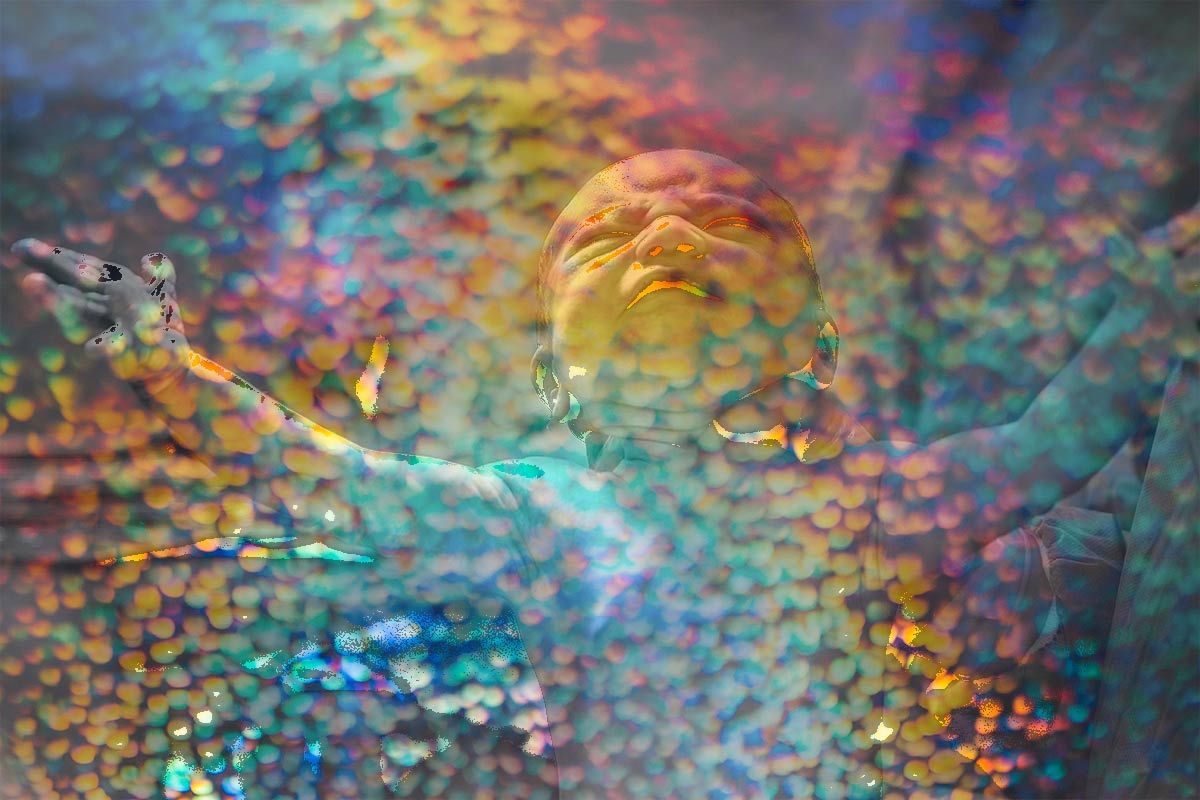Birth is a powerful process of preparation, transformation, and reintegration, and offers an inspiring metaphor and impactful lessons that parallel the psychedelic experience. Join Kate Kincaid, LPC as we learn about the wisdom shared between the journey of psychedelic healing and the process of birth.
I wish someone would have prepared me for how psychedelic birth is. Of course, I knew it was a big deal and that it was life changing for the birther and their family, but I hadn’t grasped how communal and primal it would feel for all involved. Not until the first birth I attended. We were about 16 hours into the ordeal while I was holding my friend’s hands, her other best friend was holding her left foot, and her partner holding her right foot. We took a moment in between contractions to look at each other and all of our pupils were almost as wide as our irises. I felt such immense love and gratitude for all of them and everyone who had ever been in this space before. Even then, I had the thought that it felt like we were all rolling on MDMA together. And just like MDMA, the waves of this peak experience took hours, if not days, to settle down to baseline.
In Ina May Gaskin’s book Spiritual Midwifery, many similar psychedelic birth experiences are described. For example, “We were riding the rushes like a surfer rides the waves”, wrote Edward of his wife’s labor. ‘The energy would swell up and Janet’s eyes would grow deeper until it seemed like I could look through them like peepholes and see the vastness of the cosmos out beyond her pupils; endless space’” [1]. Gaskin also talks about birth being an ecstatic event that is often experienced as consciousness shifting [2].
Fast forward a few years to the birth of my son, in December 2019. My partner, two of my best friends, and my home birth midwife were with me, and later described the birth as a “wild ass acid trip”. My birth also turned into a Near Death Experience (NDE) which has taken me over a year to process and fully return to the default world but maybe that’s for another post.
I’ve been a therapist specializing in psychedelic integration for several years now, and I’ve had a personal practice and interest in Non-Ordinary States of Consciousness (NOSC) for years before that. But not until I heard about the Zendo Project at Burning Man in 2015 did I see how I could meld my personal practice with my professional work. I love working with people as they prepare and then later process their psychedelic experiences. Every single one is so unique and yet, as many researchers have outlined, they all share so much in common.
After having a baby, and starting to see more clients for perinatal support, I noticed that birth stories sound a lot like trip stories. Stan Grof described basic characteristics of the Cosmic Unity Experience as: “transcendence of the subject-object dichotomy, exceptionally strong positive affect (peace, tranquility, serenity, bliss) a special feeling of sacredness, transcendence of time and space, experience of pure being, and a richness of insights of cosmic relevance” [3]. I wouldn’t necessarily have chosen those words when talking about my birth experience but upon reading them, they sure do fit. Most birthers that I have talked to describe their birth with many of these psychedelic themes too.
In my opinion, birth is transformative and often traumatic, even if it all goes according to plan. How could it not be when the birther literally splits their body into two distinct parts in a matter of hours? Trauma can result when a person fears for their life or the life of someone close to them and for many other reasons. In birth, we’re necessarily close to death because we approach the veil between worlds in order to welcome a new soul into this world. When looked at this way, we can approach processing birth from a trauma-informed perspective. Trauma-informed means you go slow and acknowledge it takes time to process and integrate.
When I train other clinicians about working with people in psychedelic or NOSC states, I sometimes use Joseph Campbell’s “The Hero’s Journey” to explain the stages of Preparation, the Ordeal (i.e. psychedelic journey), and the Return, or integration [4]. Pam England’s book “The Labyrinth of Birth”, which I unfortunately didn’t read until I was about a year postpartum, uses similar language to describe the stages of pregnancy, labor and postpartum [5]. Knowing there is a guide map but also knowing that there will be many unexpected twists and turns on the way in and out is a helpful tool for any birthing person or anyone intending to set out on any psychedelic journey.
Stages of Birth: Preparation (Pregnancy)
One walks into the labyrinth of birth and the long road into the center is a time to prepare for the Ordeal. This is the gestation period of 9 plus months that it takes to make a human baby. During my pregnancy, I recall feeling further and further away from the default world as my due date approached. I was often zoned out and quiet; in the days before the birth I described feeling close to a portal. I was in a liminal space, not what I was, but not yet what I was about to become. I felt so in tune. Many auspicious synchronicities started happening, as many psychonauts notice themselves as they prepare for a journey. I had a dream with a white veil outside my window and I felt it was a guide from beyond. I felt protected yet appropriately apprehensive.
Stages of Birth: The Ordeal (Labor)
The birth itself is the Ordeal, the Cosmic Unity Experience that Grof describes. During active labor, the birther realizes it is time to enter the center of the labyrinth alone. England says, “the journey into the labyrinth’s center is symbolic of letting go and death (psychic or physical), and the journey from the center out of the labyrinth represents birth and rebirth.” [5]. Brain waves start to slow down to theta frequencies and if allowed to do their thing, the trip is mostly self guided by the birthing person. The birther and their baby may approach the veil several times before deciding to push through and this is dependent on circumstances. If the birther is forced to answer questions or be interrupted (which is often the case in hospital births in the U.S.), they may take longer to leave ordinary reality [6].
The next phase is “Quietude” or the resting phase, it’s a short phase after intense contractions and before the final pushing phase. It’s not acknowledged in our society as a distinct phase of labor because often birthers are instructed to push as soon as they reach 10 cm dilation [6]. During my birth, I recall this phase the most. Everyone said the energy shifted and I became silent (where before I had been screaming at the top of my lungs in the most primal and cathartic way possible). For the first time in the whole Ordeal, I knew what to do. I focused on relaxing my body and trusting my reflexes to expel my baby for me. I get the chills just thinking about it. It felt good, like the best kind of relief or release, similar to purging in other psychedelic experiences.
Stages of Birth: The Return- Integration- Rebirth (Postpartum)
I spend a lot of time with my clients educating them on the importance of integration. I often say integration is the more potent psychedelic. Integration is the space where we process what happened during the Ordeal and figure out how to incorporate these new understandings into our lives. Same goes for returning to the default world after birthing a child. You don’t get to just walk straight out of the labyrinth after facing your death, being reborn and bringing a new soul into the world. You have to meander back and go through many twists and turns, trials and tribulations.
Immediate postpartum is sometimes called “the golden hour”, and in my experience this is the perfect description. I can recall the way the light looked in the room at 9:00 in the morning as we all passed my babe around; it was golden and there was literally a person playing the harp in the hallway of the hospital. I felt like I was in another world that transcended time and space and had a distinct feeling of sacredness.
What is often forgotten or less acknowledged is what comes after immediate postpartum, those harrowing days, weeks, months of healing the body from the Ordeal while also accepting a new identity and sustaining a new life. My close support network described our house as a “baby vortex”, where time was still distorted for about a month after my son’s birth. Those that have been there themselves or who have been support for people who have just had a baby probably know what I’m talking about. The house looked, smelled and felt different to all who entered. It was not unlike the days and weeks after a transformative psychedelic experience when plants and the sky and everything literally looks changed. It’s hard to integrate when you’re also actively trying to heal and survive such a life changing experience and yet this is what billions of people have done for millennia. To say it’s mind blowing to me is an understatement. Bartlett calls it “weaving the story” and says that the weaving goes on forever. And that’s an appropriate metaphor in my experience so far. It can take up to 3 years to feel fully “back”. But I wonder if you ever really are?
References
- Gaskin, I.M. (1977). Spiritual Midwifery: Revised Edition. Summertown: The Book Publishing Company.
- Gaskin, I.M. (2003) Ina May’s Guide to Childbirth. New York: Bantam Books.
- Grof, S. (1972). Varieties of Transpersonal Experiences: Observations from LSD Psychotherapy. Journal of Transpersonal Psychology, 4:1, p. 51.
- Campbell, J. (2014). The Hero’s Journey. New World Library.
- England, P. (2010). Labyrinth of Birth. Seven Gates Media.
- Bartlett, W. D. (2021, July 18th) Holistic Stages of Birth. The Matrona. https://thematrona.com/the-holistic-stages-of-birth/







